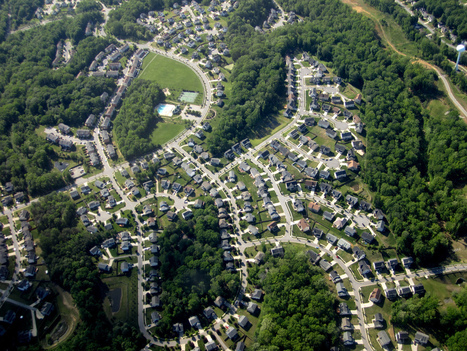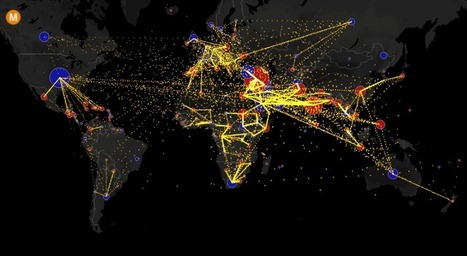In which John Green teaches you about population. So, how many people can reasonably live on the Earth? Thomas Malthus got it totally wrong in the 19th century, but for some reason, he keeps coming up when we talk about population. In 1800, the human population of the Earth passed 1 billion, and Thomas Malthus posited that growth had hit its ceiling, and the population would level off and stop growing. He was totally right. Just kidding, he was totally wrong! There are like 7 billion people on the planet now! John will teach a little about how Malthus made his calculations, and explain how Malthus came up with the wrong answer. As is often the case, it has to do with making projections based on faulty assumptions. Man, people do that a lot.
Get Started for FREE
Sign up with Facebook Sign up with X
I don't have a Facebook or a X account
 Your new post is loading... Your new post is loading...
 Your new post is loading... Your new post is loading...
Jordyn Reeves's curator insight,
January 11, 2017 3:44 PM
This relates to our topic by showing that our population is growing rapidly. By the time 2025 there will be more than 11 billion people on the Earth. But we have enough resources to last us.
Alexandra Piggott's curator insight,
October 18, 2014 6:48 PM
This is also an issue in Australia where the overwhelming majority of people live in single story dwellings and are very car reliant. 
Joshua Mason's curator insight,
January 28, 2015 8:59 PM
I can definitely see this as a real problem. Both my Uncle and my Great Uncle moved their condos from ones that had numerous steps to climb to the second floor to more elder-friendly options. My Great Uncle even went a step further to move him and his wife to a senior living community, where there food, entertainment, etc. is all provided within an enclosed neighbourhood with other people of their age group. More of these communities that act like oversized retirement homes could be the answer. They give the illusion of suburban living, something the baby boomers liked, while providing the accessibility they need. |

GTANSW & ACT's curator insight,
December 17, 2016 11:46 PM
Migration at a global scale changes places
Syllabus Students investigate reasons for and effects of internal migration in Australia and another country, for example:
Students investigate the reasons for and effects of international migration to Australia, for example:
Geoworld 9 NSW 8.1 Migration: people own the move 8.2 Australia: destination nation 8.3 Where do immigrants settle 8.4 Culturally diverse australia: trends in migration
8.8 Australians are mobile people 8.9 Mobile indigenous populations 8.19 Lifestyle migration 8.11 The power of resources: the Pilbara 8.12 Migration changes the USA Geothink
Alexandra Piggott's curator insight,
October 18, 2014 6:48 PM
This is also an issue in Australia where the overwhelming majority of people live in single story dwellings and are very car reliant. 
Joshua Mason's curator insight,
January 28, 2015 8:59 PM
I can definitely see this as a real problem. Both my Uncle and my Great Uncle moved their condos from ones that had numerous steps to climb to the second floor to more elder-friendly options. My Great Uncle even went a step further to move him and his wife to a senior living community, where there food, entertainment, etc. is all provided within an enclosed neighbourhood with other people of their age group. More of these communities that act like oversized retirement homes could be the answer. They give the illusion of suburban living, something the baby boomers liked, while providing the accessibility they need.

Brian Wilk's curator insight,
March 23, 2015 7:08 PM
Demographics seemingly started with age as a metric many years ago and have evolved into marketing tools, political footballs, and ways to combat everything from obesity to social security. Africa is clearly the youngest and probably for a very morbid reason; AIDS and Ebola among other diseases have taken their toll on the sexually active and thus have reduced the average age of their population. Germany seems to be the place to go for a job as the labor shortage will mean higher wages for the folks who are left. Japan has another issue; a healthy aging population that will strain the government's ability to financially take care of them. I wonder if the unevenness of Europe is an indication of the two World wars that were fought mostly on the turf. Did some countries lose more than others? If more soldiers, presumably of baby making age, perished did this affect the countries ability to keep pace with the Germany's and Spain's of Europe? Diet seems to play a large part as well as the Mediterranean is well represented in terms of age. Does their healthy diet of fish, nuts, legumes and olive oil make a difference? I could spend all day postulating, but I'll leave some of the findings for you to discover...
Deanna Metz's curator insight,
March 1, 2016 8:05 PM
The median age of a population call be a quite telling statistic--almost a surrogate for a population pyramid. I post this with a special attention to Sub-Saharan Africa; the youngest 15 countries in the world are all in Africa, one of the major demographic realities confronting African economies and politics. Here is a map with the median age of U.S. counties. Tag: population, demographic transition model, population pyramids. 
Olivia Campanella's curator insight,
October 31, 2018 11:55 AM
In the article there are 1.2 billion people between the ages of 15 and 24 in the world today. Meaning that, countries around the world have populations younger than ever! 15 of the youngest countries are in Africa. And of the 200 million young people of Africa, about 75 million are unemployed. The worlds youngest country is Niger with a population and median age of 15.1 and coming in a close second is Uganda with 15.5, but Japan and Germany are some of the Worlds oldest countries ranging in a median age of 46.1!
|














